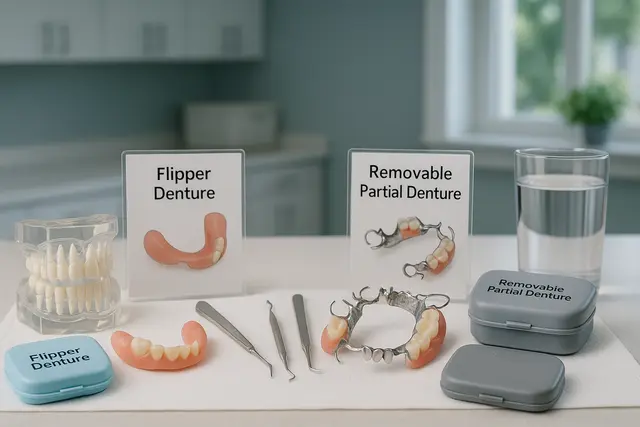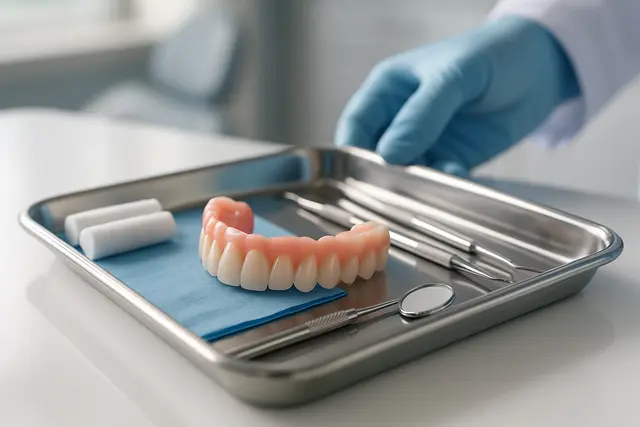Prosthodontics
5 min read
Nov 02, 2025
Flipper Teeth vs. Partial Dentures Comparison: Best Temporary Tooth Replacement
Missing teeth can impact more than just your appearance, they can affect your confidence, speech, and ability to eat comfortably. Fortunately, there are temporary solutions that offer both function and aesthetics while you plan your next steps. Two of the most common options are flipper teeth and partial dentures, each with unique advantages depending on your needs.

Tooth loss happens. Whether from an accident, decay, or just wear and tear over time, suddenly finding yourself with a gap in your smile can be upsetting, uncomfortable, and even a little embarrassing. But the good news? You’ve got temporary tooth replacement choices that not only restore function but help you smile with confidence while planning for a more permanent solution.
When you're weighing your options, the two most talked-about contenders are flipper teeth and partial dentures. While they sound similar, they serve different dental needs and come with their own pros and cons. Whether you're looking to replace one or several missing teeth, this guide is here to walk you through what matters.
Flipper Teeth and How They Work
A flipper is a lightweight, acrylic dental appliance used as a temporary solution when someone loses one or more teeth. It sort of “flips” into place, which is how it got its name. Flippers are usually made from pink denture acrylic to match your gums, with one or more artificial teeth attached. Think of them as the quickest way to fill the gap created by one or two missing teeth.
If you've ever seen someone pop a small, gum-colored piece into their mouth to hide a front tooth gap, chances are you were looking at a flipper denture. It's common after an extraction while waiting for healing before something more permanent, like dental implants.
Partial Denture Options Explained
Now, a partial denture is a removable dental device designed to replace one or more missing teeth when you still have existing teeth in place. Unlike flippers, partial dentures are often more durable and built for longer wear. Partial dentures are designed with a stronger framework, sometimes metal, sometimes flexible resin, that supports the artificial teeth attached to a gum-colored base.
A removable partial denture may replace one tooth or several teeth, depending on your needs. While they can also be used as a temporary solution, many people use them for years, especially if they’re not yet ready for permanent options like dental implants.
Dental Flippers and Partial Dentures: What's the Real Difference?
So what’s the real difference between a flipper and a partial?
Flippers are lightweight, thinner, and often less expensive. They’re quick to make and can usually be fitted soon after tooth loss. That makes them ideal if you’ve just had an extraction and need something fast to restore your smile.
Partial dentures, on the other hand, are more durable, more stable, and generally more comfortable for eating and talking over the long term. A flipper denture might shift a bit or feel fragile if you're chewing something firmer. A partial denture may offer better function and longevity, especially if it’s made with a metal base.
Pros and Cons You’ll Actually Care About
Let’s get real. You want something that looks good, feels comfortable, and doesn’t blow your budget. Here’s how flipper teeth and partial dentures stack up.
Flipper Tooth Pros:
Affordable for most budgets
Fast to make and easy to adjust
Lightweight and not bulky
Flipper Tooth Cons:
Not very durable
Can feel flimsy or unstable
Best used as a temporary solution
Partial Denture Pros:
More durable than flippers
Better for chewing and speaking
Suitable for replacing several teeth
Partial Denture Cons:
More expensive
Takes longer to make
Heavier than flippers
Choosing between dental flippers and partial dentures often depends on your lifestyle, budget, and how long you need the appliance.
Flippers and Partial Dentures From Your Dentist's Perspective
Your dentist is going to look at a few things before recommending either a flipper or partial. They’ll consider your oral health, number of missing teeth, gum condition, and what kind of future dental work you’re planning.
If you’re just looking to replace one or two teeth for a few months while healing or saving for implants, a flipper may be the way to go. But if you’re missing three or more teeth and need something more durable, a partial denture is often the better fit.
Keep in mind, impressions of your mouth are used for both types of appliances to ensure a comfortable and natural-looking fit.
Why Your Choice Matters
Think of this as short-term vs. medium-term dental solutions.
A dental flipper is a temporary fix. It's the quick solution when you’re healing or not ready for a permanent option yet. It helps you smile again and gives your gum tissue a chance to recover after tooth loss.
A partial denture is more of a commitment. If you’re not quite ready for dental implants but want something that’s functional and lasts, a partial is a smart middle ground. In fact, partial dentures are more durable and better suited to everyday wear.
Dental Prosthetics and the Role They Play in Your Oral Health
Dental prosthetics like flippers and partial dentures don’t just fill gaps, they help protect your oral health. When you lose a tooth, the remaining natural teeth can shift, affecting your bite and jaw alignment.
A removable dental device helps maintain your facial shape, supports speech, and makes eating easier. And if you care for your dental prosthetics properly, they can serve you well until you're ready for a permanent solution.
What About Dental Implants?
Many people use flippers and partials as a step toward permanent options like dental implants. Implants provide a more permanent solution but require surgery, time to heal, and more investment.
In the meantime, flippers and partial dentures provide a temporary solution that protects your gums and existing teeth. Plus, they restore your smile in a way that helps you feel more like yourself.
What to Expect at Your Dental Clinic
Your dental clinic will guide you through the fitting process. From taking impressions of your mouth to helping you try on your new appliance, your dentist is your go-to for comfort, fit, and follow-up.
Whether it’s a flipper or partial, regular dental care and check-ups help extend the life of your appliance and support overall dental health.
What Is the Difference Between Flipper Teeth and Partial Dentures?
Flipper teeth are lightweight, acrylic appliances designed primarily as a short-term solution for replacing one or two missing teeth. They “flip” into place and are typically used during healing or while planning a permanent restoration. Partial dentures, however, are more durable and designed to replace multiple missing teeth for longer-term wear. They often feature a stronger base, sometimes metal or flexible resin, and provide greater chewing stability and comfort.
When Should Someone Choose a Flipper Tooth Over a Partial Denture?
A flipper tooth is ideal when you need a fast, affordable temporary solution, especially immediately after a tooth extraction or while waiting for dental implant treatment. It works best when only one or two teeth are missing and you want a cosmetic fix during healing. A partial denture is a better choice if you’re missing several teeth and need something more stable and functional for daily use over months or years.
How Do Flipper Teeth and Partial Dentures Affect Daily Function?
Flipper teeth help restore your appearance quickly but may feel less secure when chewing and speaking, and they can break more easily due to their lightweight design. Partial dentures offer stronger bite support, improved comfort during meals, and better speech stability. Because they fit more firmly and distribute pressure more evenly, partial dentures are usually preferred for routine eating and speaking.
Are Flipper Teeth or Partial Dentures Better for Long-Term Use?
For long-term use, partial dentures are usually the better option due to their durability, stability, and ability to support multiple missing teeth. Flippers are meant as temporary appliances and may warp, weaken, or loosen with extended use. If long-term replacement is the goal, partial dentures or future dental implants provide more reliable function and comfort while preserving oral health.
Read Next
Related Posts

Prosthodontics
Differences Between Zirconia and Acrylic Dentures: Benefits, Drawbacks, and Tips
Choosing between zirconia and acrylic for dental implants can feel overwhelming, especially when both materials offer unique advantages. This guide breaks down the essential differences, benefits, and limitations of each option to help you make a more confident, informed decision about your dental restoration journey.
5 min read
Nov 03, 2025

Prosthodontics
Full Dentures vs. Partials: Key Differences, Appearance, and Performance Compared
Choosing the right type of dentures can feel overwhelming, especially if you're unsure whether full or partial dentures are better suited for your needs. Understanding the differences between these two options is key to restoring your smile, comfort, and confidence. This article explores how full and partial dentures compare in terms of appearance, function, and overall fit.
6 min read
Nov 03, 2025

Prosthodontics
Zirconia Dentures Overview: A Comprehensive Introduction
Considering dental implants or dentures but want something that feels more natural and lasts longer? Zirconia might be the solution you're looking for. Known for its durability, aesthetics, and biocompatibility, zirconia is becoming a top choice for patients seeking a more permanent and comfortable tooth replacement option.
5 min read
Nov 03, 2025
Don’t have time to research every dentist around you?
See why 30k+ patients trusted us